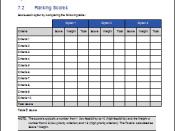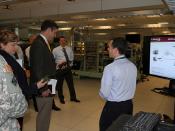Systems Development Life Cycle1. Planning:â¢An outline will be made of the proposed systemâ¢A budgeting plan will be developedâ¢A detailed development schedule will be createdâ¢Decisions will be made as to whether to modify the existing systems or build a new systemâ¢A technical feasibility analysis will determine existing technologies and any new technology that that could solve the problemâ¢An economic feasibility analysis will determine if the system is affordable and if the investment return will be adequate enough for the company.
â¢An operational feasibility analysis will attempt to determine if employees are willing and able to use the systemâ¢A schedule feasibility analysis will determine if the deadline for the project is reasonable depending on the availability of the people needed to implement the project.
The planning process allows for three alternatives: (1) keep the current system, (2) modify the current system, and (3) implement a new system. Once the company decides to implement the new system it's time to move on to the second phase of development.
2. System Analysis:â¢The company's initial problem is analyzed more thoroughly and the requirements of the information system are detailed.
â¢Requirements gathering is done to help the analyst have a more comprehensive and in-depth understanding of the company's problem and how the proposed system can solve it.
â¢Structured analysis is done by using data flow diagrams (DFD) to show the proposed system will allow data to flow through the organization.
â¢Computer-Aided Software Engineering (CASE) tools are use to simplify the proposed system through graphical imagery. CASE tools automatically confirm that diagrams are technically correct and ensure that the data flows through the correct process.
Once the system analysis is complete if there are any feasibility issues the plans will have to be adjusted. Once adjustments have been made the systems design phase can begin.
3. Systems Design:â¢Illustrates how the new system will be built i.e. what functions or parts it should contain.
â¢A logical systems design will detail the system's functionality and help explain what the system should do.
â¢Structure charts provide a detailed representation of every aspect of the new system.
â¢A physical systems design will describes the actual components that will be used to achieve functionality.
â¢Freeze: the project is frozen once the company and system development team agree on a system design.
â¢Scope creep: is then implemented as an expansion of the project. This is where any additions to the design can be made.
â¢Feature creep: can be implemented if additional features or upgrades are requested.
If scope or feature creep cause the project to go over budget or fall behind schedule the analysis phase will have to be updated to determine feasibility and adjust the budget. Once adjustments have been made the development phase can begin.
4. Developmentâ¢At this point company may decide to purchase the new system of build it themselves.
â¢Programmers will write the software.
â¢Database developers will implement the databaseâ¢Network engineers configure the internal systems and connect it to the internet.
Once the system is built, but before it can be implemented it must be tested.
5. Testingâ¢Stub testing: programming inputs and outputs are checked to ensure data flows appropriately.
â¢Unit testing: modules are put together to be sure they work properly.
â¢Systems testing: the new software, databases and network are tested for accuracy.
â¢Verification testing: the system is engaged in a simulated environment with simulated data to ensure the system is working properly.
If any errors are detected the system will go back to the development stage for adjustments. Once adjustments have been made the systems implementation phase can begin.
6. Implementationâ¢Installation: the new system components and old system data are inaugurated into the system.
â¢Direct cutover: quick exchange from the old system to a new one.
â¢Parallel conversion: the new system is installed beside the old system.
â¢Pilot testing and staged conversion: the new system is installed at only one location to be sure it works before it is installed throughout the company.
â¢Staged conversion: One part of the system is installed at a time to ensure that each part works before installing another one until the entire system is in place.
Once an installation process is chosen and the system is in working order the systems maintenance phase can begin.
7. Maintenance:â¢Maintenance is probably the most important of the seven stages of the systems development life cycle because it ensures the longevity of the system.
â¢It is also expensive in manpower because someone needs to be available to correct errors, back up and recover data, support end users, make system enhancements and so on, but it will also ensure that the system remains in working order for many decades.


